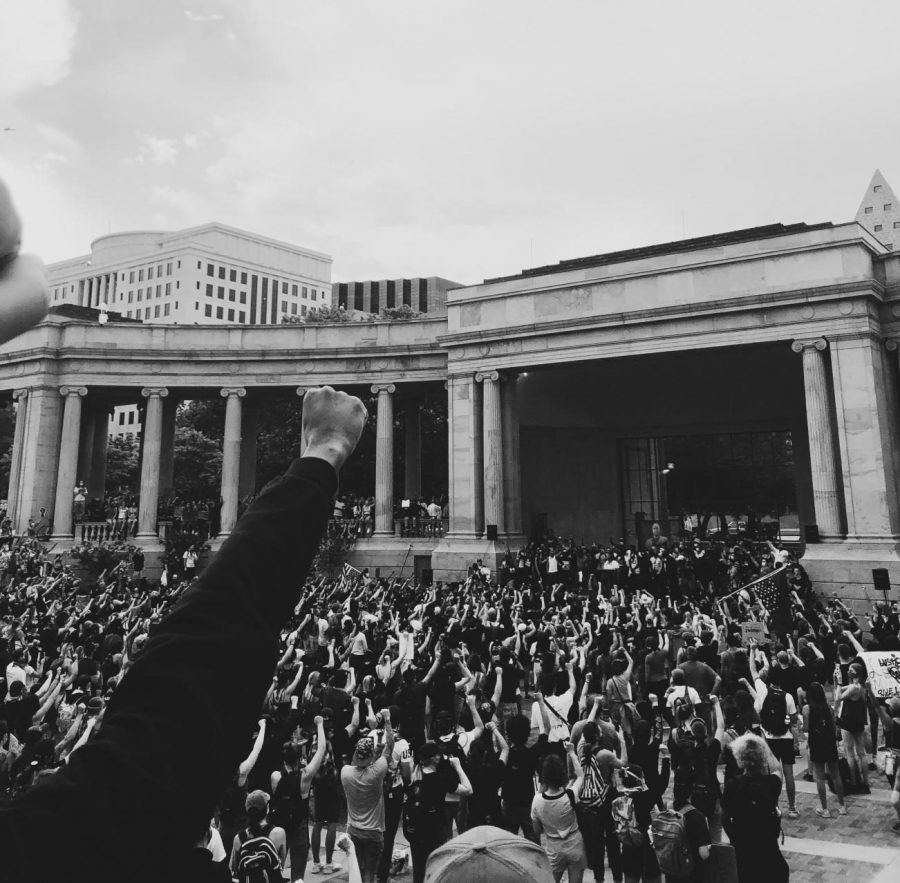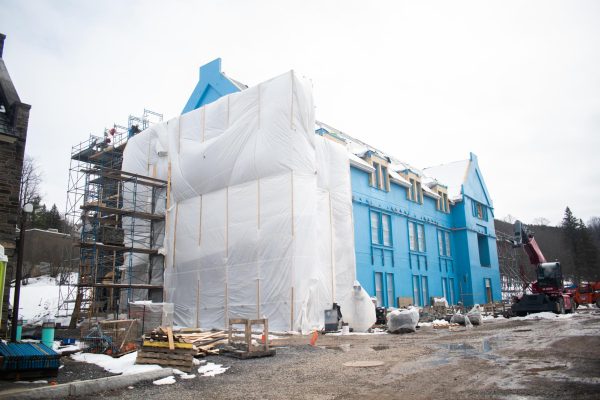Students Protest Around the Country, Reflect on Racism on Colgate’s Campus
Processing his hurt following the murder of George Floyd, junior Thomas Dunia took to the streets of Buffalo, New York to demand justice for victims of police brutality. Like many Colgate students, Dunia joined nationwide protests against systemic racism and police brutality in recent weeks. Following Floyd’s killing at the hands of Minneapolis Police, outrage spread throughout the country with protests in all 50 states and across the world, sparked by not only the injustice of Floyd’s death, but countless other Black lives lost to police violence: Breonna Taylor, Ahmaud Arbery, Philando Castile, Michael Brown, Eric Garner and many more.
“[I was] taking in the pain that I’ve been feeling as a black man, but also other people who have been experiencing racial discrimination for years,” Dunia said. “Everything culminated in this moment where I was standing and watching people cry out in pain.”
Protesting at the center of the movement in Minneapolis, junior Shiv Janjee spoke of the turmoil in his city and his near disbelief.
“You hear about this stuff on the news, and you see all of the police brutality, and then it happens ten minutes from where you live and it is real,” Janjee said.
Janjee described much of Minneapolis as peaceful and somber with the exception of areas surrounding Lake Street, where Floyd died. On that street and the surrounding area, protestors painted “Justice for George” and “I can’t breathe” murals honoring Floyd on boarded up buildings. On a surrounding highway, Janjee reported seeing a group setting cars on fire and smashing windshields.
“I think the fact that protestors burned down a police precinct, and the Mayor let them, shows that people are really starting to understand what is happening,” Janjee said of systemic racism in law enforcement. “I’ve never had a doubt that there is systemic racism, but this brought it so close to home. I would have never expected this to happen in Minneapolis. I just thought it was more progressive than that.”
Even in rural, historically white towns like Homer in Central New York, residents are joining the fight supporting Black Lives Matter.
“This cause is something that is very important to me and something that I think should be brought to life, especially in Homer, and it made it more impactful knowing our demographic was not in favor of what we were protesting,” Homer resident and junior Nina Armideo said, a member of College Democrats and the Student Government Association.
Armideo marched through her town with a group of about 30 other protestors, halting at their village green. Over the course of four hours, the group received polarizing reactions from those passing by, ranging from families honking and cheering in support, to motorcyclists and trucks revving their engines and shaking their head in disapproval.
“Some people would yell ‘all lives matter,’ some would yell ‘blue lives matter.’ There were a lot of different reactions,” Armideo said. “Some people were confused. You could physically see that some people were totally unaware of the subject, people trying to read the signs and make out what they meant.”
Junior Adrienne Vaughn, a student activist from outside of Washington, D.C. involved in BSU, Student-athletes of Color Connect (SOCC) and the newly formed Colgate Student Coalition, said protest goes far beyond holding signs and chanting in the streets. She explained that donating, educating, serving low income and communities of color and calling out racism in conversation are all important forms of protest.
“You can protest in so many ways,” Vaughn said. “No one should feel like they aren’t helping just because they aren’t a body on the frontline.”
Vaughn said participating in protests brings her a sense of satisfaction.
“I think that something that is actionable is so satisfying,” Vaughn said. “You’re actually out there, you’re expressing yourself, your voice has to be heard when you’re protesting. That’s the most frustrating part of all of this is; that you don’t feel like you’re contributing.”
A History of Racism and Protest
Social justice activist and scholar in U.S. history, African American women’s history and the carceral state, Visiting Assistant Professor Dionne Bailey said the Black Lives Matter movement centering current protest follows a long history of activism for racial justice in the U.S.
“We have a long tradition of protests,” Bailey said. “You go from Harriet Tubman, DuBois, Baldwin, Ida B. Wells, Frannie Lou Hamer—there’s always people who have led some type of protest and this is just where we are—2020.”
Bailey warned, though, of the consequences of historical outrage over racial injustice that has often omitted the experiences of Black women and girls.
“You have activists [and] scholars who are now making it a point to make sure that Black girls and women are included in the conversation when we think about social injustice,” Bailey said. “We’ve always seen these structures affect Black women. It’s not even an oversight, it’s an omission. We know that these things do have grave effects on their lives.”
According to Bailey, current systems of policing, a central topic of national outrage, are situated in a long history of state-sanctioned violence.
“When we think historically, we think of the police state, that’s where we are,” Bailey said. “You go back to black men and women and children being lynched; police were sanctioning that… you just begin to see the ways in which the state was sanctioning these type of activities and were not protecting their citizens, and we have to acknowledge that just because a person is considered a citizen, doesn’t mean they are treated that way.”
Much of the conversation through national media centers around debate over violence associated with protest. Bailey considers the dangers of using coded language such as “looters” and “rioters,” which she said reads as an attempt to police how Black communities mourn.
“There is no space for a person who is not dealing with these types of systematic injustices on a daily basis from when they wake up to when they go to sleep and even in their sleep—there’s no way that a person who doesn’t have to deal with that has the space, or the room, or the right to tell someone else who is living and breathing and could possibly die fighting injustice, how to do that,” Bailey said.
Bailey referenced a cycle of outrage that often follows widely publicized incidents of police brutality in recent history, speculating that this time, things may be different.
“We’ve seen this many times over just the last few years… and then people just go back to their daily lives. I think now, we’re probably, most likely in a different situation. This isn’t just a moment, this is a lifetime’s worth of work,” Bailey said.
Racism at Colgate
As national outrage extends far beyond issues of police brutality, students called upon the University and their peers to evaluate the structures and cultures which perpetuate racism on Colgate’s campus.
Vaughn said that dismantling cultures of racism on campus must begin with institutional change by the administration.
“You can lead a horse to water but you can’t make them drink,” Vaughn said. “You can make people care by providing them with more experiences with Black people, and the institution has sole impact on who we’re exposed to just by who they admitted to campus.”
Calling for changes to the curriculum, Dunia said that a mandatory class on race, power and inequality is necessary to not only make the campus more equitable, but to equip students to actively combat racism beyond Colgate’s campus.
“If students are not educated about Black experiences, about minority experiences, they might be the next cop who’s standing right next to a cop that’s kneeling on a black man’s neck and not say anything about it,” Dunia said.
Dunia said that changes must also address Colgate’s social structures. To reduce barriers that prevent minority students from participating in the mainstream social scene, Dunia proposed scholarships to increase the financial accessibility of Greek life for minority students, social intermixing of Greek and non-Greek student groups and diversifying music played in social spaces.
“It’s one thing to invite minorities into your house, but it’s another to make it feel like home… you need to make it so everyone can enjoy it, have a great time and let go. And through this, relationships can be formed,” Dunia said. “That is how you create empathy, and that’s how you make it show, even in classrooms, even in protests, you have more kids from [Greek] organizations, you have more white kids fighting side by side with us to create change on campus, but also as a nation.”
After attending a protest in Boston and events in her hometown, Senior Georgie von Furth reflected on her contribution to these exclusionary systems.
“It has really opened my eyes to understanding the way that I operate socially on campus is in an exclusive, non-inclusive way,” Von Furth said. “There have been a lot of times, thinking back I’ve realized, where I have not been doing enough to participate in and advocate for diversity on this campus.”
Beyond curriculum and structures that perpetuate racism on campus, students expressed frustration with the continued pattern of racist incidents on campus over recent years.
“It is insane to me that every single semester, without fail, there is at least one instance of a racial hate crime on campus,” Byers said. “And there is maybe a week of discussion about it, but basically what happens is you don’t talk about it in your classes, you don’t talk about it with your friends and then whoever perpetrated the crime is never found out and never gets in trouble.”
Co-President of Brothers and President of BSU senior David White said perpetrators of racist acts on campus, who are seldom held accountable, act in fear and cowardice.
“When everything comes about and people hear about it, [the individuals responsible] are too afraid to step up and admit that it was them,” White said of last fall’s ‘whiteboard incident,’ where a student found a racial slur targeting their suitemate on a white board outside their dorm. “[Perpetrators] aren’t confident with who they are. If they were, we wouldn’t be wondering who it was for so long. That’s the cowardice of it.”
Even years after incidents, White said the rhetoric surrounding them is often problematic.
“It’s hard to see people cracking jokes about it,” he said of the ‘glue gun incident’ in 2017, where campus went into lockdown after a black student was falsely reported to have a gun in the O’Connor Campus Center (COOP). The reported gun was a glue gun for a class project.
“It was a traumatic incident for [the victim] to go through,” White said.
Even in the spaces where inclusive conversations of race and injustice do occur, Armideo said she feels the physical locations of these spaces represents a failure of administration to prioritize inclusion.
“ALANA [Cultural Center] is on the outskirts of campus and the Women’s Studies center is in the basement of a dorm. These spaces aren’t highlights and it really does show within our student involvement,” Armideo said.
Online Activism
Social media is as active as the streets with content about protests and systemic racism flooding Instagram, Twitter and Facebook. Experts and activists warn of the power and the dangers of online activism.
Vaughn said she feels frustrated by seemingly disingenuous social media trends like #BlackoutTuesday. Instagram users took to their accounts posting pictures of a black screen on Tuesday, June 2 with the hashtag #BlackoutTuesday in efforts to show solidarity and support for the Black Lives Matter movement. Controversy arose after many posts used hashtags #BlackLivesMatter and #BLM, drowning out crucial information for protesters and the larger movement spread via those hashtags. While #BlackoutTuesday initially intended to center black voices, many say the posts instead silenced them and other substantive information.
“It just seems like it’s meant to make other people feel better about themselves and it’s not coming from a genuine place,” Vaughn said.
White also said the attempt failed to make a tangible impact.
“Some people just jump on the bandwagon,” White added. “With blackout Tuesday, just posting black squares but not actually doing anything or thinking that it is all you have to do. No, that is not going to do anything, that is not going to have an impact. That is not going to make a change anywhere to anyone.”
Bailey said that while social media is a critical tool in protest and activism, genuine action and allyship must extend far beyond online spheres. She stressed the importance of unseen methods of activism, including conversations with family members, friends and classmates.
“We do get this sort of performative aspect and we don’t know if it’s good or bad because it is still making people aware,” Bailey said. “This is people’s life’s work, this isn’t just a hot topic. This isn’t something you just decide to join and say, ‘I’m going to be a part of this for right now and the optics look good and don’t want people to think that I’m racist or that I don’t support Black Lives Matter’…I’m more interested in what people do in private than it public.”
Many agree though, that social media does play an important role in activism. Byers stressed the importance of using social media as a means for self-education and sharing resources.
“I have been posting resources and things you can tell your family if they don’t understand what is going on, and a lot of people have been responding to my stories saying thank you, this is what I needed to show my parents or family because I didn’t know what to tell my family or how to handle it,” Byers said. “It is overwhelming because there are so many triggering things being posted and traumatic videos of police brutality and such but at the same time it is so important to go on and see that this is happening.”
Continuing The Conversation
As city streets and social media feeds begin transitioning to a new normal, Bailey said the continued genuine action of white allies is critical in creating tangible, long-term change beyond days of intense protest and public discourse.
“The people who are often called on or asked to speak are tired,” Bailey said. “It’s exhausting work. You live something everyday, but then have to teach and educate and speak out and protest. We need that kind of action. You need to see that action from those who are allies to join forces and to have a voice but to make sure it is coming from the right place.”
Inspired by the motivation of her generation to create tangible change combating racism, Vaughn feels young people will have an immense impact on dismantling structures of racism in the U.S.
“Everything has shown that our generation is gonna be the one to do it. All of this has shown that,” Vaughn said. “People need to stop being afraid of speaking up, and just speak up. Stop thinking about it so much about it, just say something.”
White said he feels a similar inspiration seeing young people take action.
“These are people our age,” White added, “and these are people being inspired to actually want and do better, to actually do the hard work to make change happen, [which is] actually really inspirational to me and something I try to incorporate on our campus.”
Going forward, Von Furth plans to attend more speakers and events related to racial justice to participate more actively in anti-racism on campus. Like Armideo, she felt particularly uplifted by her small, predominantly white town’s involvement in the Black Lives Matter movement.
“We are not in a very inclusive environment,” Von Furth said of her hometown, Northampton, Massachusetts. “But a lot of the ways in which funds are being raised and discussions I have been having with my friends have given me hope. It’s okay to recognize the mistakes that I have made in my past and steps I haven’t taken, but now that I am cognizant of those I can change for the better.”
In order for institutional change to prosper, Bailey underscored that social justice work must be a continual effort beyond cycles of injustice and public outrage.
“It doesn’t end when the cameras are off,” Bailey said. “It doesn’t end when the news stations begin to report on other things.”

Kirby Goodman is a senior from Minneapolis, Minnesota concentrating in peace and conflict studies with a minor in political science. She's previously served as...
Greta Ferdinand is a senior from Portsmouth, NH concentrating in mathematics with a minor in philosophy. She has previously served as news editor and contributes...









